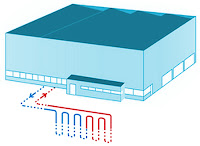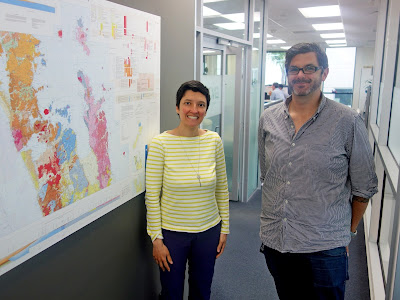The Sydney Opera House is one of the symbols of Australia. If the iconic edifice is a masterpiece of architecture, it is also thanks to engineering choices. Concerning ventilation, such a large building should have ventilation openings, or chimneys, or cooling towers. The Australian opera house does not. How is that? Thanks to a particular ventilation system which uses the cold or hot waters from the harbor nearby!
NATURAL DIFFERENCES OF TEMPERATURE
 In a previous article we talked about geothermal energy: deep underground hot water is used to generate electricity or heat buildings. Well, regarding heating and cooling a building, a more simple technology also exists, called ground source heat pump (GSHP) system or geothermal heat pump system. Such system consists of pipes buried under the building and tied to its ventilation system (the pipes can also go through large liquid reservoirs). Water circulates into these pipes. During winter, the ground temperature is higher than outside. It means that hot water goes up to the building, and heats it. During summer, the system can be inverted. The ground is colder; cold water goes up and cools down the construction! The few degrees of difference between the ground and the outside do the job.
In a previous article we talked about geothermal energy: deep underground hot water is used to generate electricity or heat buildings. Well, regarding heating and cooling a building, a more simple technology also exists, called ground source heat pump (GSHP) system or geothermal heat pump system. Such system consists of pipes buried under the building and tied to its ventilation system (the pipes can also go through large liquid reservoirs). Water circulates into these pipes. During winter, the ground temperature is higher than outside. It means that hot water goes up to the building, and heats it. During summer, the system can be inverted. The ground is colder; cold water goes up and cools down the construction! The few degrees of difference between the ground and the outside do the job.
“Heat pump systems exploit natural differences of temperature!” says Huw. Huw Williams is a Senior Hydrogeologist and GeoExchange Designer working at Engeo. In the past he worked for the United Kingdom Environmental Agency. Engeo is based in New Zealand and California and specializes in geothermal heat pump systems in particular. We had the chance to meet Huw in Engeo offices in Auckland, New Zealand.
“Advantages of the technology are numerous,” Huw says. “The consumption of electricity is much lower compared to a standard ventilation system. It avoids combustion and greenhouse gas emissions compared to fossil-fueled electricity.” According to New Zealand Wairakei Research Center, energy consumption can be reduced by up to 70%. Huw adds: “Maintenance costs are lower. The system also requires less equipment than traditional ventilation: in large buildings it leaves lots of free space on the ground floor and on the last floors where equipment are usually installed. Finally the system is silent, whereas traditional ventilation material can be noisy.”
Since the pipes are buried underground, we asked Huw about their resistance against earthquakes. New Zealand is a seismic place. We could experience it when a strong earthquake struck New Zealand South Island in mid-November. “The pipes are made of an advanced plastic, high-density polyethylene (HDPE),” Huw says. “They are both resistant and flexible. After the major earthquake of 2011 around Christchurch in New Zealand, we found that nearly all the pipes were undamaged. Basically the pipes move with the ground!” The ground pipes actually have a life expectancy of 50 years.
PAYBACK IS BETWEEN 3 AND 7 YEARS
With all these advantages, why isn’t the technology more common? “The answer is that the initial expenses are higher than traditional ventilation systems,” Huw replies. “Installation costs are high because of the drilling and the ground works. Also the upstream design activities are more complex. However in Europe, North America, China and Korea the adoption is high. Indeed the payback is not long: between 3 and 7 years. So lots of owners make the calculation and choose the geothermal heat pump system. After it is paid back, it offers many years of savings in energy costs!
Financial incentives and regulation shall help. In the United Kingdom, the Merton rule is a recent law which obliges all new large buildings to consume at least 10% of self-generated renewable energy. Thanks to it, more and more new constructions integrate a geothermal pump system.” Huw concludes: “This underground energy is free. Globally speaking, each time nature offers energy for free, we should use it! In a sustainable way of course.”
APPLICATIONS ARE MULTIPLE. SAVINGS ARE NOT LACKING.
In California, the biggest project in the world is ongoing: a large heat pump system will heat and chill 11000 homes, schools and malls. Also in the USA, the IKEA shop of Denver, Colorado, goes even further: the system creates ice during the night, at a low energy cost, in order to cool the building the following day! The overall electrical demand is much lower.

In Franz Josef, New Zealand South Island, a heat pump system will be used soon to heat pools! We went there and met Ana Vivas who is the Manager of the pool center. “Soon we will stop burning natural gas to heat our pools,” Ana says. ”It means less greenhouse gas emissions. Also the hazards related to our large boilers will disappear. The upstream system, including boilers and tanks, will be dismantled and replaced. The new upstream heat pump solution will simply be connected to the existing downstream distribution system. That will be soon, in March!”
Like various other technologies, heat pump systems have been available for a long time but are not yet common enough. Innovation will be mandatory to build sustainable cities but promoting existing efficient technologies will also be necessary. Regulation must help.
NATURAL DIFFERENCES OF TEMPERATURE
 In a previous article we talked about geothermal energy: deep underground hot water is used to generate electricity or heat buildings. Well, regarding heating and cooling a building, a more simple technology also exists, called ground source heat pump (GSHP) system or geothermal heat pump system. Such system consists of pipes buried under the building and tied to its ventilation system (the pipes can also go through large liquid reservoirs). Water circulates into these pipes. During winter, the ground temperature is higher than outside. It means that hot water goes up to the building, and heats it. During summer, the system can be inverted. The ground is colder; cold water goes up and cools down the construction! The few degrees of difference between the ground and the outside do the job.
In a previous article we talked about geothermal energy: deep underground hot water is used to generate electricity or heat buildings. Well, regarding heating and cooling a building, a more simple technology also exists, called ground source heat pump (GSHP) system or geothermal heat pump system. Such system consists of pipes buried under the building and tied to its ventilation system (the pipes can also go through large liquid reservoirs). Water circulates into these pipes. During winter, the ground temperature is higher than outside. It means that hot water goes up to the building, and heats it. During summer, the system can be inverted. The ground is colder; cold water goes up and cools down the construction! The few degrees of difference between the ground and the outside do the job. |
| Huw and Carolina in front of a geological map of New Zealand. |
“Advantages of the technology are numerous,” Huw says. “The consumption of electricity is much lower compared to a standard ventilation system. It avoids combustion and greenhouse gas emissions compared to fossil-fueled electricity.” According to New Zealand Wairakei Research Center, energy consumption can be reduced by up to 70%. Huw adds: “Maintenance costs are lower. The system also requires less equipment than traditional ventilation: in large buildings it leaves lots of free space on the ground floor and on the last floors where equipment are usually installed. Finally the system is silent, whereas traditional ventilation material can be noisy.”
Since the pipes are buried underground, we asked Huw about their resistance against earthquakes. New Zealand is a seismic place. We could experience it when a strong earthquake struck New Zealand South Island in mid-November. “The pipes are made of an advanced plastic, high-density polyethylene (HDPE),” Huw says. “They are both resistant and flexible. After the major earthquake of 2011 around Christchurch in New Zealand, we found that nearly all the pipes were undamaged. Basically the pipes move with the ground!” The ground pipes actually have a life expectancy of 50 years.
PAYBACK IS BETWEEN 3 AND 7 YEARS
With all these advantages, why isn’t the technology more common? “The answer is that the initial expenses are higher than traditional ventilation systems,” Huw replies. “Installation costs are high because of the drilling and the ground works. Also the upstream design activities are more complex. However in Europe, North America, China and Korea the adoption is high. Indeed the payback is not long: between 3 and 7 years. So lots of owners make the calculation and choose the geothermal heat pump system. After it is paid back, it offers many years of savings in energy costs!
 |
| ©Ikea |
APPLICATIONS ARE MULTIPLE. SAVINGS ARE NOT LACKING.
In California, the biggest project in the world is ongoing: a large heat pump system will heat and chill 11000 homes, schools and malls. Also in the USA, the IKEA shop of Denver, Colorado, goes even further: the system creates ice during the night, at a low energy cost, in order to cool the building the following day! The overall electrical demand is much lower.

In Franz Josef, New Zealand South Island, a heat pump system will be used soon to heat pools! We went there and met Ana Vivas who is the Manager of the pool center. “Soon we will stop burning natural gas to heat our pools,” Ana says. ”It means less greenhouse gas emissions. Also the hazards related to our large boilers will disappear. The upstream system, including boilers and tanks, will be dismantled and replaced. The new upstream heat pump solution will simply be connected to the existing downstream distribution system. That will be soon, in March!”
During our visit, Ana showed us the large volume of equipment (boilers, tanks, etc.) which will be dismantled after the heat pump system is on.
Like various other technologies, heat pump systems have been available for a long time but are not yet common enough. Innovation will be mandatory to build sustainable cities but promoting existing efficient technologies will also be necessary. Regulation must help.
We visited the site few days after the drilling works ended. Impressive drilling!
~~~~~~~~~~~~~~~~~~~~~~~~~~~~~~~~~~~~~~~~~~~~~~~~~







No comments:
Post a Comment